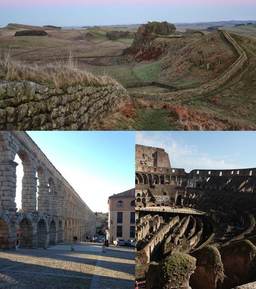 'What did the Romans ever do for us?' Hadrian's wall (top), aqueducts in Segovia (bottom left), and the Coliseum in Rome (bottom right) 'What did the Romans ever do for us?' Hadrian's wall (top), aqueducts in Segovia (bottom left), and the Coliseum in Rome (bottom right)
One of the challenges of having a weekly blog is not knowing at what time or from where inspiration will come. Sometimes I have ideas in the queue for weeks at a time, other times I’m scrambling on a Tuesday night to come up with something for the next day. This week I’m leaning towards the latter approach, especially after returning from a long weekend/Easter holiday.
While I passed most of the weekend enjoying the sights, wine, and sunshine of central Spain, I realized that one of my favorite parts of travelling around Europe isn’t experiencing the modern-day cuisine and the culture, it’s the history and legacies that were left behind for us today that still inspire and motivate me. In particular, I love seeing the remnants of the Romans. On our first day trip from Madrid we traveled to the walled city of Segovia, which has an in-tact Roman aqueduct that was in use up until the 19th century. The aqueduct is imposing and impressive, nearly 100 feet tall (or 28.5 m, since this is a science blog after all) and stretches 15 km from the city walls. Not only is the original design impressive in its own right, the antiquity of the construction—which was started sometime near 50 AD—adds to its magnificence. We took the time to wander along the aqueduct trail to and from the city, and while admiring the structure I couldn’t help but think of the other impressive works that the Romans left behind. From the awe-inspiring views along Hadrian’s wall as it stretches across the Northern English countryside to the first moment when you see the grandeur of the Coliseum, you can’t help but be impressed by what was accomplished nearly two thousand years ago in a time with no computers, phones, cars, and a multitude of technologies that seem integral to our lives today. While I am certainly not an expert in Roman history, my trips to museums and my brief bits of reading about that period of history has given me an impression of how Rome functioned and thrived. As the saying goes, ‘Rome wasn’t built in a day’, and the breadth of the empire also wasn’t won overnight. It was only through years of wars and also diplomacy that the empire became what it was at its height, stretching from Turkey and Northern Africa all the way to England. But holding that much land in a time without telecommunication of any form required more than just military might. Part of what makes Rome stand out, and makes their monuments still stand today, is the recognition that infrastructure was the key to keeping things in order, in making people happy, and in building an empire that would last beyond one person’s lifetime. Say what you will of the finer details of how things were done in Rome, as it certainly had its fill of bad emperors, slave-based labor, and probable constant lead poisoning, but Rome as a whole was committed to keeping itself together. While other empires may have been held in tact by a single person, as with Alexander the Great whose empire fell apart at his death, Rome lasted and held itself strong for generations. Caesar Augustus commented on Alexander’s downfall in a quote by Plutarch: “He [Caesar Augustus] learned that Alexander, having completed nearly all his conquests by the time he was thirty-two years old, was at an utter loss to know what he should do during the rest of his life, whereat Augustus expressed his surprise that Alexander did not regard it as a greater task to set in order the empire which he had won than to win it.” So where am I going with this, apart from sharing my love of Roman history? One of the reasons that I’m always inspired by the Romans is the fact that they built things to last, and built things for the Empire and not just for themselves. While emperors certainly had nice places to live and probably led better lives than most people in Rome, some emperors like Hadrian (whose wall in England still stands to this day) spent a lot of his time as ruler travelling around and decreeing construction projects for public buildings and infrastructure that everyone could use. While self-indulgence is always a part of being an emperor, king, or leader, the best leaders recognize that giving something back to the people that work for you is better than rewarding yourself for your own leadership achievements. From the perspective of scientific research, Rome can provide us with a means by which to think about the type of work we do. We can make great achievements in knowledge and write the best papers ever, but if this work ends when we retire then what sort of legacy does it leave behind? If we focus only on conquering and not building an infrastructure, will things fall apart once we step away? Just as Rome wasn’t built in a day, great science also takes time to come to fruition, and the greatest scientific achievements were never done for self-indulgent purposes but instead were done while working towards a greater, longer-lasting good. As you think about your own research, envision a legacy and think of how your work can provide a framework of understanding for future researchers I mean, if the Romans could do all the things they did in the world that they lived in, how much could you achieve given the technology and the knowledge that we all have today? Comments are closed.
|
Archives
August 2018
Categories
All
|
Addtext

 RSS Feed
RSS Feed